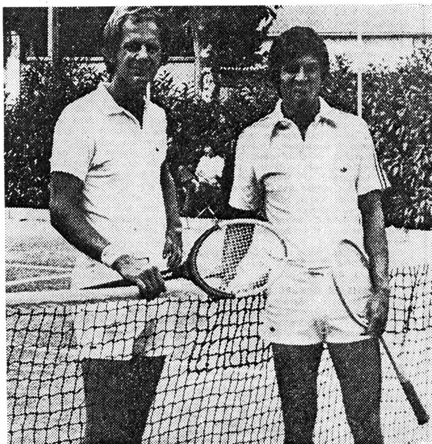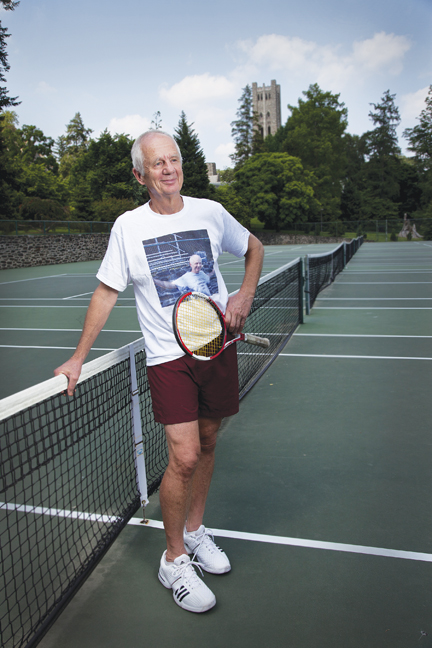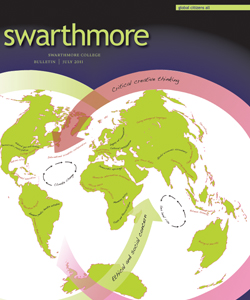More Teams to Coach, More Fun to Have
Professor and Coach Mike Mullan Gives No Hint of Retiring. Plus He Works in a Building That’s Named for Him. How Cool is That?
Mike Mullan’s office is, to put it kindly, a bit of a mess. The one presumed “guest” chair has a half-case of bottled water barely hugging its seat. A desk is filled with tennis balls, balancing as they can, with various bandages and wraps intertwined. There are old Swarthmore pennants and well-worn books and tennis gear here and there. The walls have a framed diploma from Temple University, slightly askew, and a similarly tilted clipping from a far-off romance-language newspaper.
But that’s how it goes when they name a building for you while you are still working in it.
“There is an image I have to uphold,” Mullan says with a twinkle-eyed smile. “I’m still not sure what that image is supposed to be, but I hope it’s fun.”
The office is tucked in the back of the Michael L. Mullan Tennis Center—three indoor courts and a fitness center—named in 2000 to honor the longtime men’s tennis coach by Mullan’s friend and frequent tennis partner Jerome Kohlberg ’46.
Mullan doesn’t just coach tennis; his other title is professor of sociology. He has a Ph.D. in history and resolved when he came to Swarthmore in 1978 that he would continue his research and teaching on the effects of sport in society. His recent course War, Sport, and the Construction of Masculine Identity explores how— both in sport and combat—cultural ideals of manhood are related to tests of skill and physical exertion. The sociology class is cross-listed in both the Gender and Sexuality Studies and Peace and Conflict Studies programs.
“Students at Swarthmore are so engaged and inquisitive, it never gets old. They’re that way on the tennis court, too—although there they don’t seem to have any trouble saying what they think when they think I’m wrong,” Mullan says with a chuckle.
At 62, the lanky Mullan has that slight stoop many tennis players get from whipping their bodies forward on zippy serves and pounding forehands. He grew up near Swarthmore in Springfield, Delaware County, and played No. 1 singles and No. 2 doubles at the University of California–Berkeley from 1967 to 1971. He continues to play competitively and recently arranged a trip to Italy to play in a 60-and-over tournament.
Though Mullan has accomplished much of what he set out to do at Swarthmore, he gives no hint of retiring. “More teams to coach, more things to research, more fun to have,” he says.
How did you get good at tennis?
My father had taught himself to play, and we joined the very pedestrian, socially mixed Idle Hour Tennis Club in Drexel Hill. Even though I was mostly self-taught, I got good enough to play on the national junior circuit. My father just gave me a little money and put me on a Greyhound bus in Philadelphia at age 16 to go to Louisville for the national clay court championship. It was a different time.
What was it like at Berkeley in the late 1960s?
We didn’t have a great stadium to play in—just six courts on top of a parking garage. We’d have great matches with UCLA, USC, and Stanford, but tennis was less fancy back then. It was raucous and difficult to find your way as a student athlete at Berkeley. You had citizenship in multiple nations. You were part of a vast rebellious group of students, but as an athlete, there was a balance you had to have. I don’t know if I always did that well.
And after graduation?
My doubles partner and I bought round-the-world plane tickets. We played tournaments in New Zealand and Australia, trying to crack in. Then we went to Burma and taught in Mandalay on courts built by the British. We played the Indian circuit and taught clinics in Kathmandu and even Kabul. We did the European circuit until it got too cold and then went off to Israel.
I taught on a kibbutz in the Negev settled by Argentinean Jews in the 1920s. It was so hot there that I couldn’t start until about 11 at night. I’d teach through the night—armed guards would appear out of nowhere, put their Uzis on the bench, and pick up a racket. We’d play for an hour, then they’d pick up their machine guns and disappear. I would sit there in silence until someone else would pop in. That was fun.
Did you ever beat someone famous when you were younger?
My only claim to fame was that I beat Dick Stockton. I had set points on Roscoe Tanner. My doubles partner and I had match points on Jimmy Connors and Jeff Austin at UCLA and didn’t convert. Now you realize how hard it is. These were the champions, and we were just circuit rabbits.

Mike Mullan (left, at a French match ca. 1972) has brought Swarthmore's men's tennis team to 28 NCAA Divison III tournaments, winning three national championships and being named Division III Coach of the Year in 1986.
Why did you quit the circuit?
It was a good idea, but a failed outcome. I could have stayed on longer and wasted more time. Fortunately, Swarthmore was there to rescue me.
What’s been your favorite course to teach?
The one I taught recently has a sort of pretentious title—War, Sport, and the Construction of Masculine Identity. It’s about how people are socialized into sports, what kinds of opportunities are available to young people, and what happens when playing becomes a burden. Another facet is how sport becomes one of the only safe topics for fathers to talk about with their sons. I can give you all sorts of examples of how fathers and sons avoid emotional topics, or if they do go there, spin the conversation back to “Hey, how about those Phillies?”
What did you learn when you took Swarthmore’s team to Japan?
My wife, Marsha, is a Japanese American, and I have a great appreciation for her culture. Japanese tennis is very traditional and ceremonial. Before each match, there’s a huge gathering. The team lines up and the coach speaks to the team. There is a lot of bowing and deference to the coach. I wish I could have that deference, but that just isn’t going to happen.
We played by Japanese rules. In each corner of the court, four people are actively engaged as cheerleaders—two for each team. I told the guys there would be a lot of noise every time the other side won a point, which is exactly the way it was. Despite all the preparation, our guys became unraveled.
What’s it like having a building named for you?
When Jerry wanted to give a tennis building, he called me up and said, “Mike, I want to name it after you.” I said, “I don’t know whether I want that, because I’m still alive. Aren’t there any better dead people you can name it after?”
 Email This Page
Email This Page
